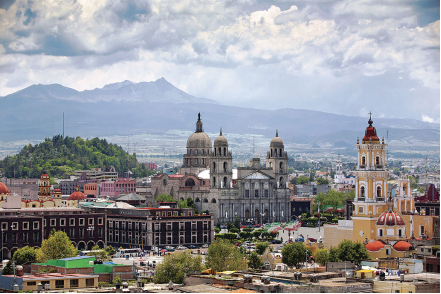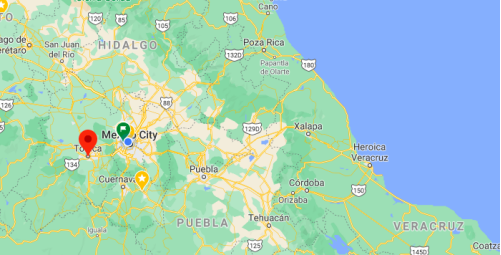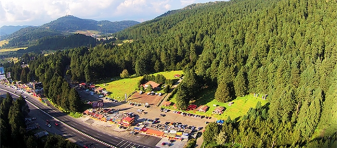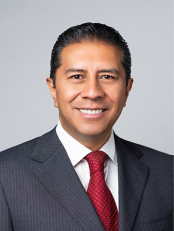Toluca, State of Mexico 作者: 来源: 发布时间:2021-07-22
1.Basic data
Pop.: 819,561 (munip.)
Area: 452.37 km2
Elev.: 2,660 masl

2. Natural geography
The most important volcanic level is the Xinantécatl or Nevado de Toluca, formed by alternating emissions of pyroclastic products and spills. In the central part, next to the municipal head, rises a system of hills with branches. It is formed by the hills of Huitzila, Cóporo, Zopilocalco, Toloche and San Miguel, which to the southwest and west form La Teresona, a sloping hill that connects at one end with the small hill of Coatepec; Calvary stands in the center of the city.
Towards the south of the head is the hill of Tlacotepec; to the north are Miltepec and Santa Cruz, on whose hills the Teresona and Tenishmo or Cerro de Calixtlahuaca meet. Describing an elevation towards the southwest is a chain of hills that culminates in the Tecaxic hill.

The Lerma River flows from Lake Almoloya del Río through the center of the municipality towards the west, flowing into Lake Chapala. From this point westward the river takes the name of Río Grande de Santiago. And it goes from this lake to the Pacific Ocean in the state of Nayarit. The river is about 1,180 km (730 mi) long; about 60% of it is known as Lerma River and 40% as Santiago River. The Nevado de Toluca or Xinantécatl is 30 km (19 mi) southwest of the city. The god Tolo was supposed to reside in the volcano's crater. Its original indigenous name was Chignahualtecatl which means "Nine Mountains" but later was named Xinantecatl which means "naked man", because the silhouette of its crater resembles a sleeping man, before the Spaniards named it Nevado, meaning "snow-covered". It is a place of increasing sporting activity, such as mountain biking, climbing, and high altitude running. It is the only volcano in Mexico that has two lagoons and can be reached by automobile. There have been proposals to turn this mountain into a ski hill because of its accessibility and the low temperatures that exist on the mountain throughout the year, but recent reports on global warming have raised fears that the snow cap on the mountain will disappear completely within a few decades. The area was converted into the Nevado de Toluca National Park in January 1936 with about 1,517 km2 (585.7 sq mi) in area.[13] The park has forest land, especially of pines and obeto trees.
The flora of the municipality is made up of pine, aile, ocote and oyamel forests, among others.
Currently the following species are found: quail, larch, dwarf chara, white-tailed deer, snow rabbit or teporingo, roadrunner and raccoon, although they are being increasingly reduced.
http://www.inafed.gob.mx/work/enciclopedia/EMM15mexico/municipios/15106a.html
Weather
Köppen Classification: Oceanic Subtropical Highland Climate
The subtropical highland variety of the oceanic climate exists in elevated portions of the world that are within either the tropics or subtropics, though it is typically found in mountainous locations in some tropical countries. Despite the latitude, the higher altitudes of these regions mean that the climate tends to share characteristics with oceanic climates, though it also tends to experience noticeably drier weather during the "low-sun" season. In locations outside the tropics, other than the drying trend in the winter, subtropical highland climates tend to be essentially identical to an oceanic climate, with mild summers and noticeably cooler winters, plus, in some instances, some snowfall. In the tropics, a subtropical highland climate tends to feature spring-like weather year-round. Temperatures here remain relatively constant throughout the year and snowfall is seldom seen.Without the elevation, many of these regions would likely feature either tropical or humid subtropical climates.
The Köppen Climate Classification subtype for this climate is "Cwb". (Oceanic Subtropical Highland Climate).
The average temperature for the year in Toluca is 56.3°F (13.5°C). The warmest month, on average, is May with an average temperature of 60.8°F (16°C). The coolest month on average is January, with an average temperature of 50.4°F (10.2°C).
The highest recorded temperature in Toluca is 92.3°F (33.5°C), which was recorded in May. The lowest recorded temperature in Toluca is 17.1°F (-8.3°C), which was recorded in January.
The average amount of precipitation for the year in Toluca is 29.4" (746.8 mm). The month with the most precipitation on average is July with 6.1" (154.9 mm) of precipitation. The month with the least precipitation on average is February with an average of 0.3" (7.6 mm). In terms of liquid precipitation, there are an average of 129.5 days of rain, with the most rain occurring in July with 23.3 days of rain, and the least rain occurring in December with 2.3 days of rain.
Getting there and around
By plane
Toluca has its own international airport (IATA: TLC, ICAO: MMTO) serving many private jets, some U.S. airlines (e.g., Spirit Airlines) and several Mexican airlines (e.g., Interjet).
International airport in Mexico City is another alternative.
By train
There is no passenger train. Rail transportation is used only for merchandise. A commuter train from Mexico City to Toluca is in the works, but its completion is planned for 2022.
By car
The highway between Mexico City and Toluca is one of the most modern in the country (and an expensive toll road). Although modern, this highway can be quite hazardous as it climbs up to above 10,000ft. The weather is very unpredictable and often involves rain, dense fog, and hail. The often poor road conditions, coupled with fast-driving commuters causes frequent crashes, many times fatal. As long as you are aware and driving responsibly, you should be fine.
Once you are in the city, the traffic can be horrendous, and not only during rush hour. The infrastructure has really failed to keep up with the burgeoning population and can cause massive traffic jams anywhere where two or more roads come together. Unless absolutely necessary, you should plan to drive during off-peak times.
Drivers commonly ignore speed limits, stop signs, and traffic lights, so even if you have the right of way, you should always be vigilant and aware. As with any cities, be aware of drunk drivers in the late evenings and weekends.
Another thing to note is that Toluca does not have a city-sponsored bus system. This means that roads are often clogged with aggressive, competing buses that stop any time someone waves their arm on the sidewalk. Don't follow too close or you might end up rear-ending them.
By bus
To TOLUCA AIRPORT from MEXICO CITY: The easiest way to get to Toluca Airport from Mexico City is with the Caminante shuttle, which costs 70 pesos as of Oct, 2016. These minibuses depart from the bus station next to the Observatorio metro station in Mexico City. The schedule depends on the day, you can check online on their Spanish language website caminante-aeropuerto.com, under the menu "Shuttle" - "Terminal de Autobuses Poniente (Observatorio)". The second table has the departure times to the airport. The trip takes about 50 minutes.
Toluca has one of the largest bus terminals in the country. From Mexico City you can get several lines to Toluca at the western terminal called Observatorio (at the end of the east-west subway line). Flecha Roja has regular service to the northern terminal, Terminal Norte, as well. Buses for Toluca depart every few minutes. Some lines (e.g., Caminante) have on board movies. From the north side of Mexico City, there is a terminal at Cuatro Caminos also with buses to Toluca. Other buses run from the suburb of Naucalpan to Toluca.
From the main Toluca terminal you can go to any points west (e.g., Michoacan), south (Ixtapan de la Sal), or north (e.g., Queretaro).
Toluca also has another station on Fidel Velazquez just for Caminante busses that have hourly service to the Mexico City airport.
Taxi - Toluca has the best taxi system in the world: over 5,000 taxis for a city of about half a million. Just walk to any major street and wave at a passing taxi. The city is fairly compact, so fares are pretty cheap: 30 pesos will take you to most places. If you are feeling adventurous, you can wave down a "micro-bus" that are often pale green and white-colored. They will only cost between 5-10 pesos per ride, but their drivers can be pretty crazy and you need to read the signs in the front window that show where the bus drives to. He may not stop all the way while you are deboarding.
Uber/Cabify - Don’t take street cabs in Toluca City if you are unfamiliar with the capital and/or don’t speak much Spanish: if you are visiting the city, get your hotel to phone a cab, use a taxi rank cab (see notes above), or use your smartphone to arrange a service like Uber or Cabify.
https://www.mexperience.com/transport/taxi-travel-in-mexico/#51
3. Economy
GDP: 16,878 M USD
4. Industry
In colonial times, Toluca first gained economic importance as a producer of smoked and cured meats, especially chorizo sausage. The nearby town of Lerma still carries on this tradition. However, since that time, Toluca's economy has expanded far beyond sausage to become one of the most industrialized areas in Mexico. Its geographic position in the center of the country and proximity to Mexico City as well as its well-developed infrastructure, have allowed Toluca to grow into a major industrial zone for the state. Toluca began consolidating in the 1940s, but the most intense industrialization began in the 1950s and continued through most of the 1980s. The growth and industrialization of Toluca is closely tied to the growth and changes in economic activities that have occurred in the Mexico City metropolitan area. Most industrial enterprises are on the small and micro-level but the city has attracted a large number of international corporations. Major products produced include food processing, metals and machinery, paper products, printed matter as well as auto production. The industrial base of the Toluca metropolitan area employs over 33% of the municipality's population and 6% of the entire state's population.
Outside of the metropolitan area, the economy is still based on agriculture and livestock, with some income from tourism. Only a little over four percent of the total municipal population engages in agriculture raising corn, wheat, beans, potatoes, peas, fava beans and oats on a little over half of the municipality's territory. Livestock raising is a greater source of income with 10,286 sites producing cattle, pigs, sheep and domestic fowl. Tourism is based on the Nevado de Toluca volcano and the archeological zone of Calixtlahuaca. Despite being little known internationally, they manage to represent about 50% of the state's tourism income.
Toluca lies in the southern part of the valley and its economic influence is most strongly felt in the southern and central parts of the valley. The northern parts of the valley have closer ties to Atlacomulco. The core metropolitan area of Toluca consists of the municipalities of Toluca, Lerma, Metepec, San Mateo Atenco, Ocoyoacac and Zinacantepec. The economic interdependence of these municipalities are most similar to that of the communities in the Mexico City metropolitan area. There are two "outer spheres" of the metropolitan area. The first consists of the municipalities of Almoloya del Río, Capulhuac, Mexicaltzingo, San Antonio la Isla, Tenango del Valle and Xonacatlán. The furthest sphere consists of Santiango Tianguistenco, Santa María Rayón, Santa Cruz Atizapán and Chapultepec, México. These spheres are defined not only by geographical distance but also by population growth and rate of urbanization.
Industrial zone
Toluca is located in the economic center of Mexico. Toluca has become an important economic city because of its industries and infrastructure that produce drinks, food, textiles, cars, electric products and such. Since 1944, many industries have settled in Toluca rather than in other cities. In 1965, the industrial zone of Toluca-Lerma-Tianguistenco, which is located on the north side of Toluca, began to attract industries to the area. The city now has five additional major industrial parks: Corredor Industrial Toluca, Parque Industrial Lerma, Parque Industrial Exportec I., Parque Industrial Exportec II and the Parque Industrial El Coecillo.
Chrysler's Toluca Car Assembly has manufactured automobiles since 1968. The 220-acre (0.89 km2) complex — where the FIAT 500 is assembled — employs 2300 people. Other companies located here and other of Toluca's industrial parks are BMW, Mercedes Benz, Coca-Cola, Femsa, Grupo Bimbo, Nissan, Nestlé, Pfizer, Bayer, Crisa, Barcel, Knorr, Trelleborg Automotive, and HSBC.[24] have complete manufacturing and R&D facilities in the Toluca industrial park. Mercedes-Benz manufactures the C-Class, E-Class, G-Class, here and upgrades the GL-Class, S-Class and CLS-Class to armored vehicles at this facility. BMW manufactures its 3, 5, 7 and X5 series and also offers armored variants.
5. Touristic sites
Nevado de Toluca National Park

The Nevado de Toluca National Park is located southwest of the city of Toluca, Mexico State. It was decreed a park in 1936, primarily to protect the Nevado de Toluca volcano, which forms nearly the park's entire surface and is the fourth highest peak in Mexico. It is 45 km from Toluca and 135 from Mexico City. The park was established with the aim of conservation, but the park is under increasing pressure from the growth of the Toluca metropolitan area as well as from illegal logging done by local communities who need the income. The volcano has been long extinct and has a large crater in which are two shallow lakes. The crater and lakes are popular with visitors from Mexico State and Mexico City, especially when there is snow. There are a number of archeological sites in the park, including the lakes themselves, which contain numerous offerings of copal and other items that were deposited during the pre-Hispanic period. The park offers activities such as hiking, mountain biking and horseback riding as well as limited skiing facilities. Due to its altitude, the summit of the Nevado is significantly colder than the surrounding area.
Cosmovitral

The Cosmovitral is a stained glass mural and botanical garden located in Toluca, Mexico. The building takes its name from the mural which is set in the building's huge windows that surround the building and in the ceiling. The building originally was constructed in 1910 as the 16 de Septiembre Market. It was not until 1975 when the first female Mayor of Toluca, Yolanda Sentíes, had the 16 de Septiembre Market reallocated and successfully gauged enough social and political support to transform the building into a space for art. The Cosmovitral was designed by the notable local artisan Leopoldo Flores.
The concept of Leopoldo Flores was novel – a mural done in stained glass that would encircle the building on its windows and run along the ceiling. Before executing it, the artist spent a year studying and developing the concept, and working out the engineering issues. The name of the mural is Cosmovitral, which is an amalgam of “cosmos” and “vitral” (Spanish for glass). The name is now used for the building as well as the artwork. The theme of the work is “Man and his relationship with the universe.”
La Marquesa National Park

The park is situated west of Mexico City and east of Toluca, the capital of the State of Mexico. It is also west of the Desierto de los Leones National Park. Most of the park's forests are on the north side of the highway.
It commemorates the battlefield site of the 1810 Battle of Monte de las Cruces, one of the pivotal battles of the early Mexican War of Independence in New Spain.
It is one of the most visited national parks protected, is located in the vast expanse of the Sierra del Ajusco or Sierra de las Cruces; It covers some 1,760 hectares of pine, fir and cedar. Throughout the year and especially on weekends, receives thousands of visitors who come to perform various activities such as hiking, camping, mountain biking, fishing, horseback riding, rent ATVs and camping.
https://www.zonaturistica.com/en/things-to-do/estado-de-mexico/toluca/la-marquesa-national-park
6. History and Culture
Pre-Columbian era
Tlatoāni Axayacatl, Aztec emperor from 1469 to 1481, under whom the Kingdom of Calixtlahuaca was conquered and annexed by the Aztec empire.
The Valley of Toluca was known as Matlatzinco Valley in ancient times and home to at least four linguistic groups: the Matlatzinca, Otomi, Mazahua, and Nahua peoples. In the Postclassic period, the valley was ruled by a large powerful capital city whose ruins are located today in the village of Calixtlahuaca, just north of the city of Toluca. In 1478 the Mexica emperor Axayacatl conquered the Toluca Valley. The capital was stripped of its dynasty and power and some lands were distributed to kings and nobles from the Valley of Mexico.
One of the rivals of Calixtlahuaca was Tollocan, a minor city-state before 1478. When Axayacatl destroyed Calixtlahuaca, he placed the imperial provincial capital in Tollocan. Calixtlahuaca and other towns in the Toluca Valley paid tribute to the Aztec Empire through Tollocan. After the Spanish conquest, the name Tollocan was changed to Toluca. Archaeologists have not yet located a major Postclassic settlement within the modern city. Either the pre-Hispanic city of Tollocan was destroyed and covered over by the expansion of Toluca, or else the remains of Tollocan could lie outside of the modern city. A small Postclassic site was discovered on the hill called Tolochi, which is in the north of the modern city, but the remains seem too insubstantial to have been a major provincial capital. The tree of "Las Manitas Rojas", which literally means "little red hands", was planted before the Spanish Conquest in what is now the monastery of Nuestra Señora del Carmen. This tree is significant because it shows that Toluca was important enough for the Aztecs to create a botanical garden.
Colonial period
In 1521, the Spanish conquered the Valley of Toluca. Leading the troops was Gonzalo de Sandoval, one of Cortes' many sergeants. Toluca's first governor was Pedro Cortés Coyotzin. The valley of Toluca and what is now the city of Toluca were included in the concession made by King Carlos V of Spain to Hernán Cortés.
In 1524, the evangelization process started in Toluca. The most notable figure of this effort is Fray Andrés Castro, from Burgos, the old capital of Castile, by making a great number of improvements to the city and being the first one to learn the native Matlatzincan language. The friar was well loved by the Matlzinca people, as he worked to protect them from the injustices of the early colonial period. He is remembered to this day with a plaza that bears his name which includes a sculpture depicting him. A Spanish community was established in 1530, but it was not until 1677 that Toluca was categorized as a town. In 1793, the construction of a road to Mexico City was started. Although Toluca was recognized as a city as early as 1662, only in 1799, was Toluca officially named a city by the King Carlos IV of Spain on September 12.
Independence and post-independence
In 1810, at the beginning of the independence movement, Miguel Hidalgo stayed in Toluca for a few days on his way to the Battle of Monte de las Cruces. In 1811, a group of indigenous natives of Mexico was shot and killed by Spanish royalists. In memorial to those who were killed in this incident, the place where this occurred was named "Plaza of the Martires". In 1812, the first city council of Toluca was installed. In 1821, independence was proclaimed by the local authorities.
After the creation of the State of Mexico in 1825, the state capital moved to different cities several times. until in 1830, Toluca was finally designated as the constitutional capital of the State of Mexico. In 1832, the building of "Los Portales" was started in downtown Toluca. In 1836, because of the centralization of the Mexican federal government, all branches of government were relocated to Mexico City after some were in Toluca for several years.
In 1847, thanks to Ignacio Ramírez, "El Nigromante" or the Institute of Literature opened. In 1851, the "Teatro Principal" was built by González Arratia. Mariano Riva Palacio was named governor of the state and he started the most important modernization process of the city in the 19th century. In 1881, The Industrial Union was founded, the railroad was opened and the Bank of State of Mexico created the first bills in the country. In 1882, the Teachers College was founded. In 1910, people celebrated a century of Independence, and the Plaza España was inaugurated.
7.Contact Information
City Mayor: Juan Rodolfo Sánchez Gómez

Contact number: +52 (722) 276 1900
Govt. Office Address: Av. Independencia Pte. 207, Colonia Centro, Toluca de Lerdo, Estado de México, C.P. 50000
Twitter: https://twitter.com/JuanRodolfo_SG
FB: https://www.facebook.com/JuanRodolfoSG2019
Website: https://www2.toluca.gob.mx
E-mail: juanr.sanchez@toluca.gob.mx
